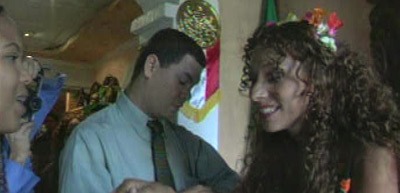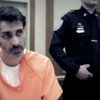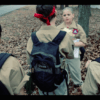
Viva La Dona
Written by Randy Steinberg | Posted by: Anonymous
Just as much of William Faulkner’s work can be seen as a metaphor for the struggles and tragedies of the South, Philip Frabetti’s film "Dona Ana" can be read as a metaphor for the Puerto Rican experience.
"Dona Ana" is divided into four vignettes. Each episode corresponds to a critical period in the history of Puerto Rico. We meet Dona Ana (Lady Ana) in the first vignette, set in the plantation era of Puerto Rico’s history. She’s a wealthy, happy mother with two beautiful children. A boating accident claims her children’s lives, but an unflinching Dona Ana vows that her children will one day return.
In the next three episodes, the ghost or spirit of Dona Ana appears to underscore the experience of her countrymen: we hurtle down through the years, stopping in the plantation era of Puerto Rico, the 1950s, when mass migration caused an economic crisis, and end in the present day where the women of Puerto Rico struggle to gain more independence and greater respect. In the final vignette, the metaphor of the island nation’s long and tortuous journey is completed, and its people are redeemed: Dona Ana’s children return to her and there is hope.
"Dona Ana" is the result of the efforts of two dedicated filmmakers — writer/director Philip Frabetti and executive producer/lead actress Nivya Barrera. Philip Frabetti had earned his degree in communications from Northeastern University, where he took several TV courses and started to get involved in television productions. He began to write short scripts and made two short films after graduation: "Revenge" and "Dinner." Soon, he branched into corporate video production, working mainly for Fidelity Investments. In the course of making these videos, Frabetti met Nivya Barrera who acted in several of his productions.
Together they embarked on a difficult journey to make the film a reality. Frabetti wrote the script and got it into Barrera’s hands. Barrera, a former police officer turned actress, was so moved by the script that she cashed in her savings to fund the film. "Nivya was the driving force behind this film," Frabetti states. "She put everything on the line to get this movie made."
Barrera also assembled a dedicated group of guerilla-style filmmakers. Undoubtedly, the biggest coup for Barrera was enlisting the support and acting skills of Lydia Echevarria. Echevarria is a grande dame (or Dona as the case may be) of Puerto Rican theater and television.
"Once Lydia came aboard to play Dona Ana," Barrera relates, "access to shooting locations became so much easier." The weight of Echevarria’s name helped to make filming in Puerto Rico much smoother than it could have been. The filmmakers also were able to cast Teofilio Torres in "Dona Ana." Torres is another well-known actor from Puerto Rico and played an important role in the island’s highest-ever grossing film, "12 Horas (12 Hours)." Torres, like Echevarria, appears in each vignette, though he plays separate characters.
Having two veteran actors in the film, however, did not mean the shoot was without rigors. "We set-up an 11 day schedule," Frabetti explains. "We worked for over 20 hours three of the days and 14 hours on the rest."
The shoot took place in Puerto Rico in June of 2003. "We had a ten to one shot ratio with a total of 472 shots," Frabetti recalls, "We had only 40 minutes to shoot each scene. The actors were rehearsing before they were fully made up or in costume, and we’d move them right in and do the scene the moment they were ready. We were constantly on the move and working so hard that I remember passing out for a minute or two anytime we had a short break. It was an exhausting eleven day shoot but well worth it." The film was edited in August and in the can by the end of the month. Only after it was shot and edited did the Puerto Rican film commission provide funding.
The funding has helped Frabetti and Barrera to take the film to festivals where the movie is gaining attention and notoriety. Critics from San Francisco to Puerto Rico are calling "Dona Ana" a low-budget "Like Water for Chocolate." "Dona Ana" premiered in the New England area on November 6, 2004 at the Center for Latino Arts in Boston’s South End and was part of an impressive line-up of films in the Boston Latino Film Festival. (www.bliff.org). Before a small but enthusiastic crowd in a former church — a truly catholic atmosphere — "Dona Ana" was received warmly. Afterwards, Frabetti and Barrera spoke about their experiences making the film and their hopes for its future.
"We intend to take the movie to film festivals as well as film and television distributors," Frabetti states. "Given Lydia Echevarria’s popularity in Puerto Rico, we feel there is a good chance a buyer can be found on the island."
Frabetti’s mantra is ‘Get It Done.’ "No matter what the budget or the nature of the material, I want people to know that I’ll get done what needs to be accomplished," he says. While Barrera attempts to sell the film, Frabetti continues to work in the Boston area as a freelance interactive producer. His clients range from Fidelity to Millennium Pharmaceuticals to a host of Bio-Medical and Pharmaceutical companies. He works with these clients to make videos, CDs, and interactive content for corporate websites.
If one thing about Frabetti is accurate it’s that with "Dona Ana" he got it done and he got it done well. "Dona Ana" is an incisive, engaging film that informs while it entertains. And with a little luck, it will get the wider audience it deserves. Viva La Dona!
To learn more about 'Dona Ana' or to contact Philip Frabetti or Nivya Barrera, write to pfrabetti@hotmail.com.











